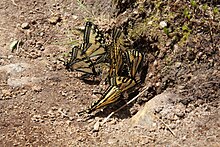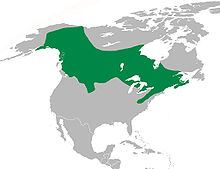Papilio canadensis
| Papilio canadensis | ||||||||||||
|---|---|---|---|---|---|---|---|---|---|---|---|---|

Papilio canadensis |
||||||||||||
| Systematics | ||||||||||||
|
||||||||||||
| Scientific name | ||||||||||||
| Papilio canadensis | ||||||||||||
| ( Rothschild & Jordan , 1906) |
Papilio canadensis , in reference to the English term "Canadian Tiger Swallowtail" as Canadian Tiger Swallowtail called, is a butterfly from the family of the swallowtail butterfly (Papilionidae).
description
butterfly
The moths reach a wingspan of 53 to 90 millimeters. Their basic color is yellow. There are four wide black stripes on the forewings. A series of yellow dots stand out from the deep black hem area. A long, narrow black stripe and a black discoid loader can be seen on the hind wings. Four large yellow spots stand out from the dark hem area. Sometimes there is a reddish spot at the apex . The hem area is usually characterized by blue spots and on the Thomus by a red spot and long tails.
Very rarely there are almost monochrome black moths. These are exclusively females.
Caterpillar
Adult caterpillars are colored green, thickened on the front part and show a yellow bulge, a light row of dots and two large, dark, yellow-rimmed and bluish pithed eye spots . Younger caterpillars resemble bird droppings in their white-brown appearance, which means they are camouflaged from predators.
Similar species
Papilio canadensis was first discovered in 1991 by Hagen et al. recognized as an independent species due to physiological and genetic differences and split off from Papilio glaucus (eastern tiger swallowtail). Animals from the north and west of North America are certainly to be addressed as P. canadensis , those from the southeast as P. glaucus . Both species occur in the northeastern overlap area. There are also hybrid forms there . External distinguishing features can hardly be made out. In these cases, specialists should be consulted for determination.
distribution and habitat
Papilio canadensis occurs east of Alaska in a wide belt across Canada to the east coast, but is absent on Labrador . In the USA some northern states are settled. The main habitat are deciduous forests as well as clearings and forest edges.
Way of life
The species forms one generation per year, the moths of which fly from May to July. They like to visit flowers to take in nectar. They are sometimes to be found in number in moist places for the absorption of fluids and minerals. The caterpillars feed on the leaves of a large number of different plants, in particular birch ( Betula ), apples ( Malus ) and poplars ( Populus ). They like to hide in leaves spun with silk threads. The pupae overwinter.
supporting documents
Individual evidence
- ↑ www.butterfliesandmoths.org
- ↑ bugguide.net
- ↑ Journal of the Lepidopterists Society (PDF; 5.0 MB)
- ↑ Comparison of glaucus vs. canadensis
- ↑ imnh.isu.edu/digitalatlas
- ^ Butterflies of Canada
Web links
- Canadian Tiger Swallowtail The Butterflies of the World Foundation


